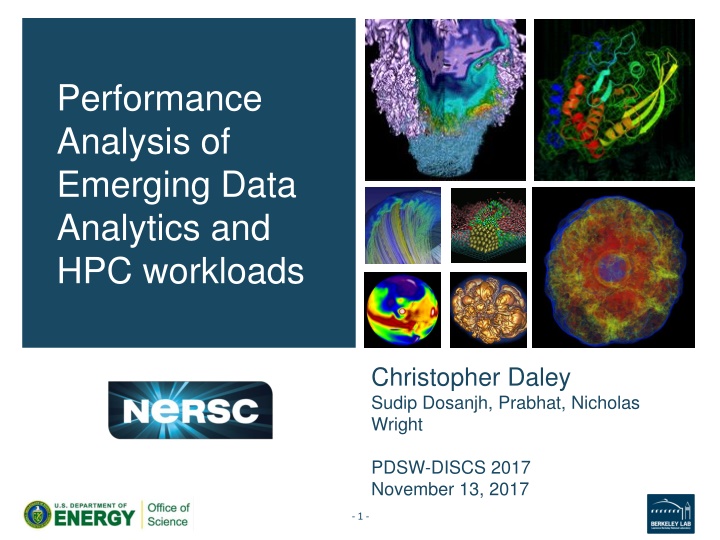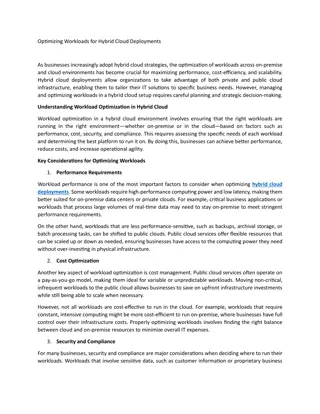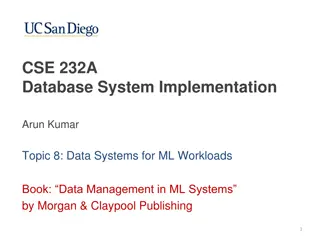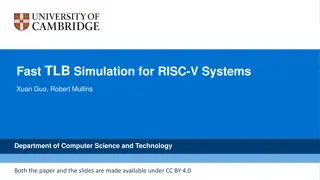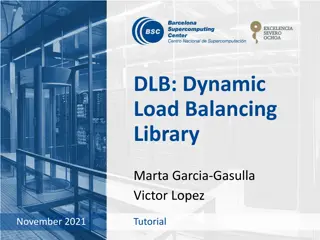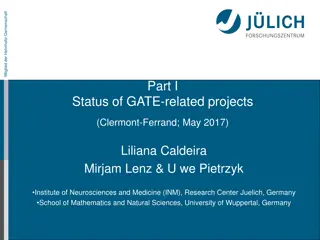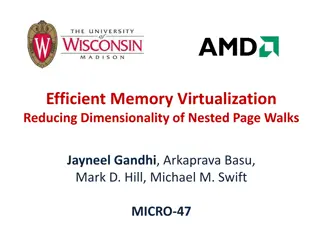Performance Analysis of Cori Supercomputer Workloads
The presentation delves into the architectural analysis of NERSC Cori supercomputer, examining its optimized compute and data partitions featuring Intel Xeon processors and Xeon-Phi processors. It highlights the benefits of a many-core processor architecture and Burst Buffer, showcasing memory configurations, network infrastructure, and I/O performance capabilities.
Download Presentation

Please find below an Image/Link to download the presentation.
The content on the website is provided AS IS for your information and personal use only. It may not be sold, licensed, or shared on other websites without obtaining consent from the author.If you encounter any issues during the download, it is possible that the publisher has removed the file from their server.
You are allowed to download the files provided on this website for personal or commercial use, subject to the condition that they are used lawfully. All files are the property of their respective owners.
The content on the website is provided AS IS for your information and personal use only. It may not be sold, licensed, or shared on other websites without obtaining consent from the author.
E N D
Presentation Transcript
Performance Analysis of Emerging Data Analytics and HPC workloads Christopher Daley Sudip Dosanjh, Prabhat, Nicholas Wright PDSW-DISCS 2017 November 13, 2017 - 1 -
Introduction The National Energy Research Scientific Computing Center (NERSC) is the primary computing facility for the Office of Science in the U.S Department of Energy (DOE) The NERSC Cori supercomputer contains different compute nodes for compute and data workloads In this presentation, we analyze representative applications to understand whether this is the right architectural approach We also consider the benefits of a many-core processor architecture and a Burst Buffer - 2 -
The two partitions of Cori supercomputer Cori-P2: Compute partition Cori-P1: Data partition Optimized for throughput and performance per watt Optimized for latency and single-thread performance 2,388 compute nodes 2 * Intel Xeon E5-2698 v3 (Haswell) processors per compute node 2.3 GHz 32 cores per node 2 HW threads per core 256-bit vector length 9,688 compute nodes 1 * Intel Xeon-Phi 7250 (KNL) processor per compute node 1.4 GHz 68 cores per node 4 HW threads per core 512-bit vector length - 3 -
The two partitions of Cori supercomputer Cori-P2: Compute partition Cori-P1: Data partition Optimized for throughput and performance per watt Optimized for latency and single-thread performance 128 GB DDR4 memory ~115 GB/s memory bandwidth 96 GB DDR4 memory ~85 GB/s memory bandwidth 16 GB MCDRAM memory ~450 GB/s memory bandwidth - 4 -
The two partitions of Cori supercomputer Cori-P2: Compute partition Cori-P1: Data partition Optimized for throughput and performance per watt Optimized for latency and single-thread performance Cray Aries high-speed network 28 PB Lustre Scratch file system ~700 GB/s I/O performance 1.5 PB Cray DataWarp Burst Buffer (BB) ~1.5 TB/s I/O performance - 5 -
Cori system architecture overview Storage Servers The user job submission script chooses Compute node type (Haswell or KNL) Number of Burst Buffer nodes - through a capacity parameter - 6 - - 6 -
Compute and data workload Applications represent the A) simulation science, B) data analytics of simulation data sets and C) data analytics of experimental data sets workload at NERSC Application Purpose A Nyx A Quantum Espresso Parallelization Nodes Mem/node (GiB) MPI+OpenMP MPI+OpenMP Cosmology simulations Quantum Chemistry simulations 16 96 61.0 42.4 B BD-CATS B PCA Identify particle clusters Principle Component Analysis MPI+OpenMP MPI 16 50 5.7 44.7 C SExtractor Catalog light sources found in sky survey images Extract Point Spread Function (PSF) in sky survey images None 1 0.6 C PSFEx Pthreads 1 0.1 - 7 -
Two sets of performance experiments 1. Analysis of baseline application performance Breakdown of time spent in compute, communication and I/O Comparison of performance on Cori-P1 and Cori-P2 2. Case studies considering how to better utilize technology features of Cori-P2 without making any code modifications Strong scaling problems to better utilize the high bandwidth memory on KNL Making use of many small KNL cores Accelerating I/O with a Burst Buffer - 8 -
Baseline application performance - 9 -
Observation #1: Common math libraries Experiments run on KNL Four of the six applications use BLAS, LAPACK or FFTW libraries (through Intel MKL) - 10 -
Observation #2: Significantly different network requirements Experiments run on KNL 0 50% of time in MPI communication - 11 -
Observation #3: Simulation data analytics applications spend more time in I/O Experiments run on KNL PCA and BD-CATS spend more than 40% of time in I/O - 12 -
Base configurations perform worse on KNL nodes than Haswell nodes I/O time is excluded Significant performance gap for experimental data analytics Higher is Better for KNL - 13 -
Baseline performance summary The same math libraries are used in compute and data workloads There are significant differences in the network requirements of applications Simulation data analytics applications spend much more time in I/O than the other applications All baseline configurations perform worse on a KNL node than a 2-socket Haswell node Experimental data analytics applications have the worst relative performance - 14 -
Optimizing the application configurations - 15 -
3 optimization use cases 1. Strong scaling the PCA application so that it fits in the memory capacity of MCDRAM 2. Running high throughput configurations of SExtractor and PSFEx per compute node 3. Using the Cori Burst Buffer to accelerate I/O in Nyx, PCA and BD-CATS - 16 -
Use case #1: Strong scaling applications to fit in MCDRAM memory capacity PCA has a memory footprint of 44.7 GiB per node Most of the compute time is spent in a matrix-vector multiply (DGEMV) kernel Performs best when data fits in the memory capacity of MCDRAM GFLOP/s/node larger than MCDRAM GFLOP/s/node smaller than MCDRAM Performance improvement Kernel Matrix-matrix multiply (DGEMM) 1561 1951 1.2x Matrix-vector multiply (DGEMV) 20 84 4.2x - 17 -
Use case #1: Strong-scaling PCA significantly improves performance I/O time is excluded Super-linear speedup on KNL as more of PCA s 2 matrices fit in MCDRAM Lower is Better PCA runs faster on KNL than Haswell at 200 nodes - 18 -
Use case #2: Using many small cores of KNL The experimental data analytics applications perform poorly on the KNL processor architecture The node-to-node performance relative to Haswell is 0.24x (SExtractor) and 0.33x (PSFEx) Both applications are embarrassingly parallel Trivial to analyze different images at the same time We consider whether we can launch enough tasks on the many small cores to improve the relative performance - 19 -
Use case #2: High concurrency per node needed to be competitive with Haswell Plot shows SExtractor application I/O time is excluded ~3x improvement in node-to-node performance Lower is Better SExtractor: 0.24x to 0.75x PSFEx: 0.33x to 1.02x - 20 -
Use case #3: Using the Burst Buffer. Overview of the I/O from the top 3 applications Application I/O time (%) API Style Overview Large sequential writes to checkpoint and analysis files (1.2 TiB) A Nyx 10.6% POSIX N:M HDF5 - ind. I/O Large sub-array reads from input file (2.2 TiB) B PCA 45.6% N:1 Large sub-array reads from input file (12 GiB) and writes to analysis file (8 GiB) HDF5 - coll. I/O B BD-CATS 41.3% N:1 A = Simulation science B = Data analytics of simulation data sets No fine-grained non-sequential I/O in any of the 6 applications - 21 -
Use case #3: The Burst Buffer improves performance for every application Higher is Better - 22 -
Use case #3: Normalized bandwidth shows satisfactory usage over a broad workload Higher fractions of peak would be possible by using more compute nodes than Burst Buffer nodes Higher is Better - 23 -
Conclusions All baseline configurations perform worse on a KNL node than a 2-socket Haswell node (Many-core is hard!) High throughput configurations of experimental data analytics improve node-to-node performance by 3x Strong-scaling an application can improve the use of MCDRAM, e.g. PCA application ran faster on KNL than Haswell at the optimal concurrency The Burst Buffer improves I/O performance by a factor of 2.3x 23.7x There is evidence that the same architectural features can benefit both compute and data analytics workloads - 24 -
Thank you. This work was supported by Laboratory Directed Research and Development (LDRD) funding from Berkeley Lab, provided by the Director, Office of Science and Office of Science, Office of Advanced Scientific Computing Research (ASCR) of the U.S. Department of Energy under Contract No. DE-AC02-05CH11231. This research used resources of the National Energy Research Scientific Computing Center, a DOE Office of Science User Facility supported by the Office of Science of the U.S. Department of Energy under Contract No. DE-AC02-05CH11231. - 25 -
Use case #1: Single-node DGEMV on KNL - PCA matrix size Matrix size of 1.38 GiB (3969 x 46715) DGEMV kernel replicated by each MPI rank 1-node DGEMV does not scale beyond 16 MPI ranks Higher is Better 50x performance deficit to DGEMM FLOP/s/node - 26 -
Use case #1: Single-node DGEMV on KNL - small matrix size Matrix size of 0.09 GiB (249 x 46715) DGEMV kernel replicated by each MPI rank This time DGEMV scales to 64 MPI ranks because aggregate matrix size < MCDRAM capacity Higher is Better 4.2x performance gain compared to using DDR memory - 27 -
Use case #1: Single-node DGEMV on KNL and Haswell - small matrix size Matrix size of 0.09 GiB (249 x 46715) DGEMV kernel replicated by each MPI rank The DGEMV kernel runs 2.7x faster on KNL than Haswell Higher is Better - 28 -
Three applications spend more than 10% of time in I/O Lower is Better - 29 -
The applications perform structured I/O with different I/O motifs Nyx Flexible N:M I/O using the POSIX API Writes a checkpoint data set of size 157 GiB and a plot file data set of size 89 GiB every single step; total of 1.2 TiB. PCA Single shared file I/O using the HDF5 API and independent access mode Simple file layout containing a single 2D HDF5 datasets; processes read a unique sub-array from the dataset Reads 2.2 TiB and process 0 writes 1 GiB BD-CATS Single shared file I/O using the HDF5 API and collective access mode Simple file layout containing 6 1D HDF5 datasets; processes read a unique sub-array from each dataset Reads 12 GiB and writes 8 GiB - 30 -
Overview of the I/O from the 3 applications spending most time in I/O The I/O styles include shared file I/O and file per process (technically N:M) Application I/O time (%) API Style Data sets I/O Nodes Node mem (%) A Nyx 10.6% POSIX N:M 5 checkpoint, 5 analysis 1.2 TiB (out) 16 10% (checkpoint), 6% (analysis) B PCA 45.6% HDF5 - ind. I/O N:1 Input 2.2 TiB (in) 50 47% B BD-CATS 41.3% HDF5 - coll. I/O N:1 Input, analysis 12 GiB (in), 8 GiB (out) 16 0.8% (input), 0.5% (analysis) - 31 -
Cori System Architecture Overview Blade = 2 x Burst Buffer Node (2x SSD) Compute Nodes: KNL and Haswell I/O Node (2x InfiniBand HCA) BBSSD CN CN CN CN CN SSD Lustre OSSs/OSTs Storage Fabric (InfiniBand) IONIB CN CN CN CN CN IB BBSSD CN CN CN CN CN SSD BBSSD CN CN CN CN CN SSD IONIB CN CN CN CN CN IB Storage Servers BBSSD CN CN CN CN CN SSD Aries High-Speed Network InfiniBand Fabric - 32 - - 32 -
